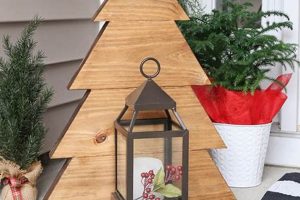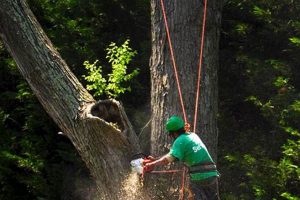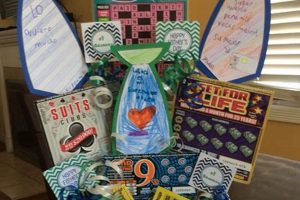Affordable decorative elements crafted for wedding receptions are a cost-effective alternative to professionally designed arrangements. These centerpieces are typically assembled from inexpensive materials sourced from discount retailers and are intended to enhance the aesthetic appeal of tables at a wedding celebration. As an example, consider using glass vases, artificial flowers, and battery-operated candles acquired from a budget-friendly store to construct a visually pleasing and economical table decoration.
The increasing popularity stems from the desire to manage wedding expenses while still achieving a personalized and elegant atmosphere. Creating decorations provides significant cost savings compared to hiring florists or event decorators. Historically, couples have sought ways to personalize their weddings, and these affordable decorations allow for unique expression and creativity. Furthermore, the process can involve friends and family, fostering a sense of collaboration and shared accomplishment in preparing for the event.
The subsequent discussion will explore various design ideas, material suggestions, and step-by-step instructions for constructing visually appealing and budget-conscious table decorations suitable for wedding receptions.
Guidance for Economical Wedding Table Decor
The following recommendations aim to assist in creating impressive wedding centerpieces using budget-friendly materials. These suggestions focus on maximizing visual impact while minimizing expenses, ensuring an elegant and memorable event without exceeding financial constraints.
Tip 1: Maximize Vase Volume: Utilize clear glass vases and fill them with water beads or decorative stones before adding floral arrangements. This minimizes the quantity of flowers required to achieve a full appearance.
Tip 2: Incorporate Reflective Surfaces: Employ mirrored tiles or metallic spray paint on select elements. These reflective surfaces amplify light and create a sense of depth, enhancing the perceived value of the decorations.
Tip 3: Strategically Use Artificial Florals: Select high-quality artificial flowers in seasonal colors. Combine different textures and sizes for a more realistic and visually appealing arrangement.
Tip 4: Emphasize Vertical Height: Create tiered arrangements by using candle holders or elevated platforms. This draws the eye upwards, adding dimension and visual interest to the table setting.
Tip 5: Implement Unified Color Schemes: Maintain a cohesive color palette throughout all centerpieces. This contributes to a unified and polished aesthetic, preventing a disjointed or haphazard appearance.
Tip 6: Consider Non-Floral Alternatives: Explore using decorative branches, pine cones, or fruit as centerpiece elements. These options can provide texture and visual interest while being significantly more affordable than fresh flowers.
Tip 7: Pre-assemble Elements: Prepare individual components, such as painted vases or floral arrangements, in advance of the wedding day. This streamlines the final assembly process and reduces stress during the event preparations.
Applying these guidelines can result in attractive and cost-effective wedding table decorations, demonstrating that elegance and affordability can be successfully combined to create a memorable occasion.
The succeeding section will offer specific project ideas and detailed instructions for implementing these cost-saving strategies in wedding preparations.
1. Affordability
Affordability serves as the cornerstone of creating wedding decorations using supplies from discount retailers. The financial constraints often associated with planning a wedding necessitate innovative solutions to achieve an aesthetically pleasing event without incurring excessive costs. Utilizing materials from budget-friendly stores directly addresses this need.
- Material Cost Reduction
Sourcing materials from dollar stores significantly reduces the expenditure on individual decorative elements. For example, vases, candles, and floral foam, which can be costly from specialty retailers, are available at fixed, low prices. This direct cost reduction allows for a greater number of decorations to be created within a fixed budget.
- DIY Labor Value
Engaging in do-it-yourself projects eliminates the labor costs associated with hiring professional florists or event decorators. The time invested by the wedding party or family members in assembling the decorations translates to substantial savings that directly improve affordability. This also fosters a sense of personal contribution to the event.
- Bulk Purchasing Benefits
Dollar stores often provide the opportunity to purchase materials in bulk, further reducing the per-item cost. This is particularly advantageous for weddings requiring a large number of centerpieces or other decorative elements. Efficient bulk purchasing strategies can optimize the overall cost-effectiveness.
- Alternative Material Utilization
Embracing affordability often leads to creative utilization of unconventional materials. Repurposing items or using budget-friendly alternatives, such as artificial flowers instead of fresh blooms, allows for maintaining visual appeal while minimizing expense. This adaptability is critical for achieving desired aesthetic results within strict financial limitations.
These aspects of affordability are integral to the feasibility of discount store wedding decorations. By minimizing material costs, leveraging DIY labor, capitalizing on bulk purchasing, and embracing creative alternatives, couples can achieve their desired wedding aesthetic without compromising their financial stability. The inherent affordability of these projects makes elegant and personalized wedding celebrations accessible to a wider range of individuals and couples.
2. Creative Materials
Creative materials form a fundamental component of crafting budget-conscious wedding centerpieces. The availability of diverse, inexpensive items within discount retailers directly influences the aesthetic possibilities and design constraints of these decorations. A reliance on readily accessible, low-cost resources necessitates resourcefulness and imagination in transforming ordinary objects into visually appealing elements suitable for a wedding reception. Without creative material selection and application, the concept of “dollar tree diy wedding centerpieces” would lack practical execution and remain purely theoretical.
The impact of creative material choices manifests in various forms. For example, utilizing glass candle holders in conjunction with decorative stones and battery-operated tea lights can mimic the appearance of high-end candle displays at a fraction of the cost. Similarly, repurposing picture frames by spray-painting them and incorporating floral arrangements or personalized messages can create unique and memorable table decorations. Furthermore, employing artificial flowers, greenery, and ribbon allows for the creation of adaptable, long-lasting centerpieces that can be disassembled and reused for other purposes following the event. Each choice impacts the final aesthetic and cost.
Ultimately, successful implementation of budget-friendly wedding centerpieces depends on embracing creative material selection and utilization. The ability to perceive potential in inexpensive items and transform them into elegant decorations is crucial. This skill mitigates the limitations imposed by a constrained budget, facilitating the creation of personalized and visually appealing wedding decorations. The challenge lies in maintaining a cohesive and aesthetically pleasing design while adhering to the budget constraints, emphasizing the significance of careful planning and material selection to achieve the desired result.
3. Simplified Assembly
Simplified assembly is a critical attribute when constructing wedding centerpieces from discount retail materials. Time constraints inherent in wedding preparations necessitate that decoration projects be achievable within a reasonable timeframe and with minimal technical expertise. Complex or time-intensive assembly processes are often impractical for couples managing numerous other wedding-related tasks.
- Modular Design
Modular designs, where individual components are prepared separately and then combined, significantly reduce the complexity of final assembly. For instance, assembling floral arrangements in small groups and then placing them into pre-decorated vases simplifies the overall process. This approach allows for delegation of tasks and parallel workflows, accelerating production.
- Pre-Fabricated Components
Utilizing pre-fabricated components, such as pre-cut ribbons or pre-painted vases, minimizes the need for specialized tools or skills. Selecting materials that require minimal alteration before assembly streamlines the construction process. The availability of such components in discount retail environments is crucial for effective simplified assembly.
- Limited Tool Requirements
Designs requiring minimal tools are essential for broad accessibility. Centerpieces relying solely on adhesive, scissors, and basic measuring implements can be readily assembled by individuals with varying levels of crafting experience. Eliminating the need for specialized equipment reduces the barrier to entry for DIY projects.
- Clear Instructions and Templates
The provision of clear, concise instructions and templates significantly enhances the feasibility of simplified assembly. Accessible visual guides, whether in print or online, minimize ambiguity and reduce the likelihood of errors. The availability of such resources can transform complex designs into manageable tasks.
The correlation between simplified assembly and successful implementation of decorations significantly impacts their practicality and appeal. By prioritizing ease of construction, couples can effectively manage their time and resources, creating aesthetically pleasing centerpieces without incurring undue stress or complexity. The selection of materials and designs that promote efficient and straightforward assembly processes is vital for the widespread adoption and application of discount retail-sourced wedding decorations.
4. Aesthetic Customization
Aesthetic customization constitutes a critical component of constructing wedding centerpieces from materials sourced at discount retailers. The inherent uniformity of mass-produced items necessitates alterations and embellishments to align with the specific aesthetic preferences of the wedding celebration. Customization transforms generic components into personalized decorations that reflect the unique style and theme of the event. The impact of aesthetic customization is evident in the ability to transform basic glass vases into centerpieces that complement the overarching wedding dcor. For example, applying paint, ribbon, or personalized labels can transform the vase’s appearance, creating a cohesive and visually appealing arrangement that aligns with the desired aesthetic.
Further examples of aesthetic customization include the selection and arrangement of artificial flowers to match the wedding’s color scheme, the incorporation of thematic elements like shells for a beach wedding or rustic wood slices for a country wedding. Creating personalized accents enhances the uniqueness of the occasion. Customized table numbers or guest names integrated into the centerpieces contribute to a cohesive and personalized aesthetic. Without these customization efforts, the centerpieces remain generic and fail to contribute meaningfully to the wedding’s ambiance. This customization is often labor-intensive, yet the personalization enhances the perceived value. Each modification plays a crucial role in the outcome of dollar tree diy wedding centerpieces’ goal.
In conclusion, aesthetic customization is paramount to the success of cost-effective wedding decorations. Through careful selection of colors, textures, and thematic elements, generic materials are transformed into personalized expressions of style. The challenge lies in balancing affordability with aesthetic aspirations, ensuring that the finished centerpieces reflect the event’s overall theme while remaining within the constraints of the budget. The combination can yield highly memorable results.
5. Budget Management
Budget management is an essential aspect of wedding planning, particularly when opting for do-it-yourself (DIY) decorations using discount retail supplies. Effective control of financial resources ensures that cost-effective decorations contribute to the overall aesthetic without exceeding allocated funds. The correlation is high.
- Cost Estimation and Allocation
Accurate cost estimation is crucial for effective budget management. Prior to purchasing materials, detailed lists of required items and their approximate prices should be compiled. Funds are allocated to each component, preventing overspending in specific areas and ensuring adequate resources for all planned decorations. This approach avoids budget creep and maintains fiscal discipline.
- Resource Prioritization
Resource prioritization involves determining which decorative elements are most critical to the overall aesthetic and allocating the majority of funds accordingly. For example, if centerpieces are deemed central to the reception dcor, a larger proportion of the budget might be allocated to their creation, potentially reducing expenditure on less prominent decorations. Strategic resource allocation maximizes the impact of available funds.
- Contingency Planning
Effective budget management necessitates the inclusion of a contingency fund to address unforeseen expenses or project modifications. A designated percentage of the overall budget is set aside to cover unexpected material shortages, design alterations, or emergency repairs. Such contingency planning safeguards against budget overruns and ensures project completion.
- Tracking and Reconciliation
Detailed tracking of all purchases and expenses is essential for maintaining budget control. Receipts are meticulously organized and reconciled against the initial budget allocation. Regular monitoring allows for the identification of potential overspending and the implementation of corrective measures. Diligent tracking and reconciliation prevent financial mismanagement and ensure adherence to budgetary constraints.
The facets of budget management are interrelated and directly impact the feasibility and success of creating wedding decorations using supplies from budget retailers. Proper planning and control ensure that resources are used optimally, enabling couples to create aesthetically pleasing decorations without incurring excessive costs. In turn, these cost savings help keep the couple within their budget for all facets of the wedding. Moreover, careful management promotes creativity and ingenuity in resource utilization, resulting in unique and personalized wedding celebrations.
6. Time investment
Time investment constitutes a significant consideration when undertaking the creation of wedding centerpieces using materials from discount retailers. The commitment of hours to design, assemble, and customize these decorations directly impacts the feasibility and practicality of this cost-saving approach. An understanding of time allocation is crucial for couples or individuals contemplating DIY decorations for their wedding celebration.
- Design Conceptualization and Planning
The initial phase necessitates the allocation of time for design conceptualization and planning. Researching design ideas, sketching prototypes, and determining material requirements demand a considerable time investment. For instance, browsing online platforms for inspiration, creating mood boards, and calculating material quantities for multiple centerpieces can require several hours or days. The intricacy of the chosen design directly correlates with the time needed for this initial stage.
- Material Sourcing and Acquisition
Sourcing and acquiring materials from dollar stores or discount retailers is often time-consuming. Visiting multiple stores to locate specific items, comparing prices, and managing inventory levels requires dedicated time. Shortages of specific items or variations in stock can necessitate additional trips or substitutions, further extending the time required for material acquisition.
- Assembly and Customization Processes
The assembly and customization of centerpieces involve the most substantial time investment. Cutting, gluing, painting, and arranging materials demands meticulous attention to detail and can be a protracted process. Personalizing each centerpiece with individual touches, such as adding custom labels or unique floral arrangements, adds to the overall time commitment. The involvement of multiple individuals can expedite assembly, but coordination requires additional time allocation.
- Troubleshooting and Reworking
Unforeseen challenges during assembly and customization often require troubleshooting and reworking, further extending the time investment. Incorrect measurements, material defects, or design flaws necessitate adjustments and corrections. Setting aside buffer time for potential problems and revisions is crucial for ensuring timely completion of all centerpieces. The availability of backup materials and tools can mitigate delays and minimize the impact of unforeseen issues.
The preceding facets highlight the significant time investment required for creating wedding centerpieces from discount store materials. An accurate assessment of available time, coupled with realistic expectations regarding project complexity, is essential for success. Efficient time management strategies, such as delegating tasks and organizing work processes, can mitigate the challenges associated with DIY wedding decorations. The benefits of saving money need to be weighed against the time investment. This balance is central to determining if the projects are feasible.
7. Visual Cohesion
Visual cohesion, referring to the harmonious integration of various visual elements to create a unified aesthetic, plays a crucial role in the successful execution of wedding decorations utilizing budget-conscious materials. The effective application of design principles ensures that individual components, often sourced from disparate locations and at varying quality levels, contribute to a unified and elegant overall impression.
- Color Palette Unification
Maintaining a consistent color palette throughout the centerpieces is paramount to achieving visual cohesion. Selecting a limited range of hues and ensuring that all elements, including vases, flowers, ribbons, and table linens, adhere to this palette prevents a disjointed or haphazard appearance. For example, employing a monochromatic scheme with varying shades of a single color can create a sophisticated and cohesive look, even when materials are inexpensive.
- Thematic Consistency
Ensuring that the centerpieces align with the overarching wedding theme is essential for visual harmony. Whether the theme is rustic, modern, or classic, the materials and design elements should reflect and reinforce this concept. Employing consistent thematic elements, such as incorporating seashells for a beach-themed wedding or using natural wood elements for a rustic celebration, enhances the overall aesthetic coherence.
- Scale and Proportion Harmonization
Maintaining appropriate scale and proportion among the various elements of the centerpieces and in relation to the tables and venue contributes to visual balance. Ensuring that the size of the centerpieces complements the table dimensions and does not overwhelm the space is crucial. Harmonizing the scale of different decorative elements, such as flower arrangements, candles, and other embellishments, creates a visually pleasing and balanced composition.
- Material Texture and Finish Coordination
The textures and finishes of the materials used in the centerpieces significantly impact visual cohesion. Coordinating the surfaces of different elements, such as combining matte and glossy textures or ensuring that metallic finishes complement each other, enhances the overall aesthetic appeal. Thoughtful consideration of material finishes contributes to a polished and refined appearance, even when using inexpensive materials.
The effective application of these elements of visual cohesion is critical for elevating budget-conscious wedding decorations from disparate components to a unified and aesthetically pleasing presentation. By carefully considering color palettes, thematic consistency, scale and proportion, and material coordination, couples can create elegant and memorable wedding celebrations without exceeding their financial constraints. The challenge lies in maintaining a cohesive and visually appealing design while adhering to the budget constraints, emphasizing the significance of careful planning and material selection to achieve the desired result.
Frequently Asked Questions Regarding Affordable Wedding Centerpieces
The following section addresses common inquiries concerning the feasibility, aesthetics, and practical considerations associated with creating wedding centerpieces using materials sourced from discount retailers.
Question 1: Are cost-effective centerpieces suitable for formal wedding receptions?
Yes, with careful planning and execution, budget-conscious decorations can be adapted for formal settings. Emphasizing design elements such as unified color schemes, reflective surfaces, and elegant presentation elevates the perceived value of the centerpieces.
Question 2: How can couples ensure the longevity of artificial floral arrangements?
Select high-quality artificial flowers with realistic textures and colors. Protect decorations from direct sunlight and dust accumulation. Store them in protective containers when not in use to prolong their lifespan.
Question 3: What alternative centerpiece options exist besides floral arrangements?
Consider incorporating candles, decorative branches, fruit arrangements, or thematic elements such as seashells or stones. These alternatives offer visual interest and can be tailored to the overall wedding theme.
Question 4: What measures can be taken to prevent centerpieces from appearing cheap or poorly constructed?
Prioritize attention to detail during assembly, ensuring that all elements are securely attached and neatly arranged. Avoid using excessive amounts of inexpensive glitter or gaudy embellishments, opting for a more refined and understated aesthetic.
Question 5: How far in advance should centerpieces be assembled prior to the wedding date?
Components such as painted vases or floral arrangements can be prepared weeks in advance. Final assembly should ideally occur one to two days before the wedding to ensure freshness and prevent damage during transportation or storage.
Question 6: How can couples ensure that centerpieces align with the venue’s existing dcor?
Consult with the venue coordinator to ascertain the space’s color palette, lighting arrangements, and existing decorative elements. Design centerpieces that complement and enhance the venue’s overall aesthetic, rather than clashing with it.
Creating visually appealing decorations using budget materials is achievable with careful planning, attention to detail, and a focus on visual cohesion.
Subsequent sections will delve into innovative design ideas and advanced techniques for crafting unforgettable wedding centerpieces on a budget.
Conclusion
The preceding exploration of “dollar tree diy wedding centerpieces” has underscored the potential for creating aesthetically pleasing and personalized wedding decorations within budgetary constraints. Key points emphasize the importance of creative material selection, simplified assembly techniques, aesthetic customization, and meticulous budget management. The success of these projects hinges on a balanced consideration of cost-effectiveness, time investment, and visual cohesion. Adherence to these principles enhances the likelihood of achieving results that are both financially prudent and visually appealing.
The crafting of such decorations represents more than mere cost-saving; it signifies a commitment to personalization and resourcefulness in celebrating a significant life event. Couples undertaking these projects contribute to the unique character of their wedding, fostering a sense of collaboration and shared achievement. As the demand for affordable wedding options continues to rise, the strategies and techniques detailed herein will likely remain relevant and valuable to couples seeking to create memorable celebrations without excessive financial burden.







